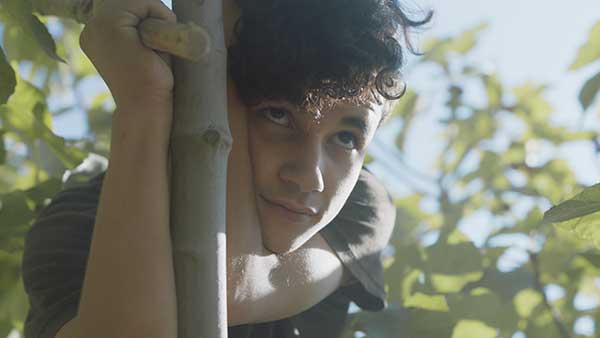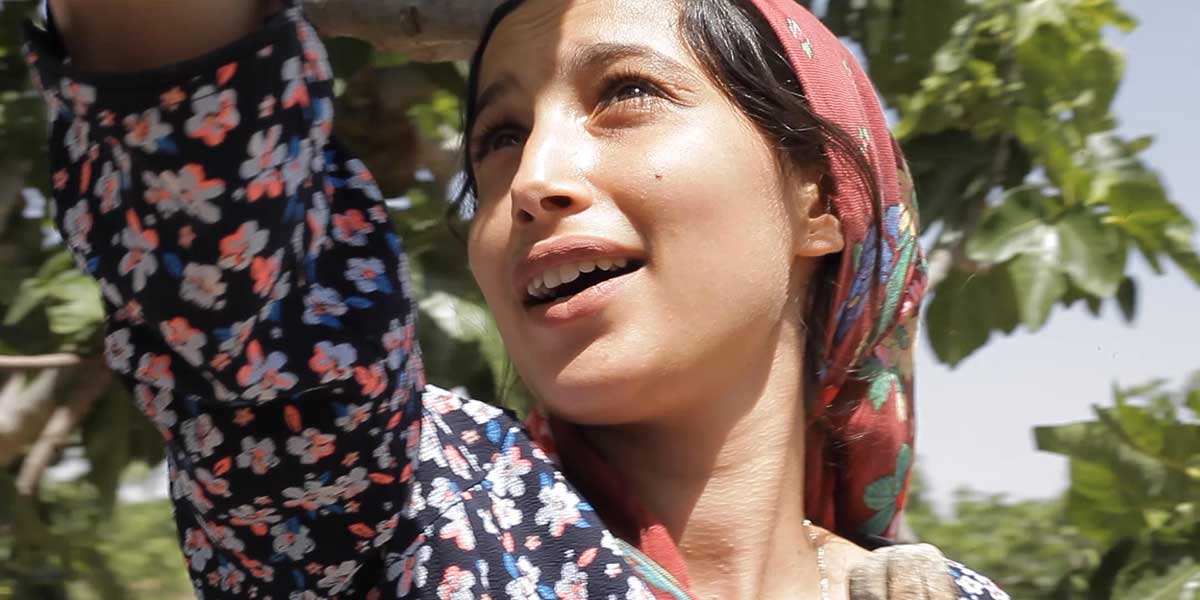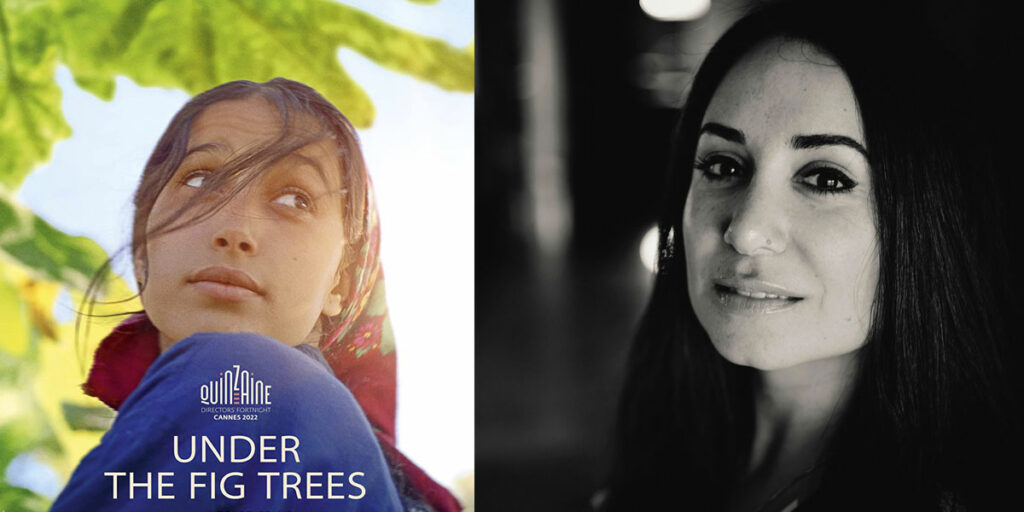We sat down with director/writer Erige Sehiri for an interview about Under the Fig Trees, her fiction feature debut that takes place across one day in a Tunisian fig orchard.
Under the Fig Trees is refined and quiet in its tone, but there is a political power operating beneath its surface. Erige Sehiri – here directing her first fiction feature after her 2018 documentary Railway Men – imbues her film with a naturalistic vibe, as we spend a single day with a group of Tunisian villagers working in a fig orchard. They are treated poorly by their boss and work for little pay, but their connections and love run deep, even to the point of fiery outbursts.
Containing a wonderful ensemble of non-professional actors plucked from the village of Kesra, Under the Fig Trees bursts with an appreciation for the intricacies of human connection and for the smaller pleasures in life. Hands touching briefly or heads resting on shoulders are given intense emotional importance. Despite these pleasures and idyllic, sun-kissed setting, danger and abuse lurk beneath the surface, with complex, difficult themes such as misogyny lying subtly but noticeably in view. Sehiri finds the perfect balance between these contrasting tones.
Beautifully composed and shot by Frida Marzouk, Under the Fig Trees plays out almost like a documentary. We as a viewer are transported to this textured setting, and invited to experience these characters’ joys and hardships with them.
Before Under the Fig Trees’release in the UK, we sat down with director and co-writer Erige Sehiri for an interview, discussing the film’s graceful intimacy, the inspiration behind its conception, and what the creative process was like for Sehiri and her cast and crew. Read our interview with Erige Sehiri below.

THE INSPIRATION: ERIGE SEHIRI ON THE CONCEPTION OF UNDER THE FIG TREES
Thank you for speaking to us today. I loved Under the Fig Trees; it is such a warm, inviting film that really transports you into its setting. What was your inspiration behind the film and its story?
Erige Sehiri: The inspiration came from a lot of different sides. I firstly wanted to work on a film about the younger generations who live in the rural parts of Tunisia. I am originally from this village, as is my father, but he left when he was 15 and emigrated to Europe. I had this idea to go back to the same place to see what has changed.
In a way, I felt as if nothing had changed, but it also very much had. The way this younger generation speaks is so different. You can tell that Tunisia had a revolution in 2011. You can feel it, even though they don’t talk about politics.
I was doing some auditions in the local area [Kesra, Tunisia] and met Fidé Fdhili [who plays Fidé], who was picking cherries after school. When I saw this, I saw a painting of young people, older men and women, and from here imagined what the conversation would be. It was a microcosm of Tunisia and the country’s military.
It started like that. It was a very organic process, a sort of impressionist kind of work. The film says a lot about our changing society and relationships between women and men.
How important was the exact setting [a fig orchard] to yourself and the story?
E.S.: It was as important as the characters. I needed to find the right place to shoot the whole film, so it was very challenging, especially because I also specifically needed figs! These fig orchards are not usually that big, so it was quite complex finding it. But it was very important to me, because I grew up with this fruit., I know the stories behind it, how the male and female fig relate to one another. It’s like a couple. The fig is a very fragile fruit, which is the way the film is, and the characters’ lives as well.
DOCUMENTARY ROOTS: ERIGE SEHIRI ON HER BACKGROUND
You have a background in documentaries with Railway Men (2018), and you also develop documentaries in your production company. How did your experience within that genre influence Under the Fig Trees?
Erige Sehiri: It is obvious that I’m coming from a documentary background when you watch the film. Now that I was working within fiction, it was fascinating to recreate life in a very naturalistic way. I had the freedom to be more spectacular within fiction, but my exercise was to search for something different. I didn’t want the audience to feel that it was all written in advance.
Under the Fig Trees subverts expectations, in that a lot of the drama goes on under the surface. There are some big arguments, but a lot of the tensions are unspoken. Was that deliberate?
E.S.: I think it was. Because it’s an ensemble film, in life when you work with anyone, you can’t go out of that space. That is the way life is. When you work with people, you don’t know everything. You have senses of what is going on, but they will never express everything that is going on. I thought it would be truer and more realistic to allow the audience to imagine, rather than showing them.

That relates back to the documentary angle perhaps. A fiction feature might have more exposition or something more sensational.
E.S.: It definitely came from my documentary background. Documentaries connect with audiences differently, and that was the same connection I was looking for.
A lot of the film is very hopeful and happy, but you also have these more serious, heavier moments. How did you find a balance between these contrasting tones?
E.S.: The balance was mainly found in the editing process. Initially, I was worried that the film would be too happy, too nice, or too naive. I came to realise that it was very close to Mediterranean culture, where people laugh and have fun but inside it is different.
In the ending scene in the truck, if you look at the film that way, it’s a happy ending. But when you look at the details of the characters’ faces, you see they are worried or tired. You have this balance. Being happy is just a moment, even freedom is momentary for them. They are not free. Inside is the suffering. We see that in the scene with Leila [Leila Ouhebi], where she is singing and crying.
I had to find this balance in the edit, and even had more dramatic scenes which were eventually not in the film. All throughout that, I was thinking, it is just one day. Maybe the worst day was yesterday or it will be tomorrow. Maybe it’s not just the worst or best day.
KEEPING IT REAL: MAINTAINING NATURALISM IN UNDER THE FIG TREES
What was the casting process like? Are they non-professional actors?
Erige Sehiri: They are all non-professional. I wanted to shoot in the area, with people from the area. That was important to me. I started auditioning in youth centres, high schools, and farms, building the group little by little. They didn’t know each other; I say village, but the area is big, cities within a countryside. There was just Fidé and her sister Feten Fdhili [who plays Melek], and one cousin, but the rest didn’t know one another. They had to learn to work together and for us to feel that they had a history together, which we built through repetition and rehearsal.
One character in the film wasn’t casted. An elderly man who argues with Fidé was a real worker. When we were shooting a scene [Fidé argues with her friend], this man didn’t understand that we were making a fiction film. He thought what Fidé was saying was true, or thought it might be a documentary. The moment we see in the film [when he argues with Fidé] is a one-take scene, where he says everything he actually felt.
That was such a striking part of the film, even more so now we know it was completely real.
E.S.: It was also amazing how Fidé improvised the scene, because she just had to roll with it!
Was a lot of the film improvised?
E.S.: The scenes were written, but what happens inside the scenes, especially some dialogues, were improvised. The actors would have the structure of a scene, but wouldn’t know exactly what the other actor would be saying to them. We also rewrote during rehearsal, keeping some of this footage when they were in costume, which are scenes we kept in the film. It made it very authentic.
UNITY AND DIVISION: GENERATIONAL DIFFERENCES IN UNDER THE FIG TREES
There is a clear difference between the generations in the film, between the younger and older people. Was this something you deliberately tried to establish?
Erige Sehiri: Definitely. You can see it in the paycheck scene with Leila and the boss. She is part of a generation before the revolution, so she has a mechanism of coping, whereby she tells the boss about what the other workers are up to. She is in survival mode. You can see the difference in the way these people walk, how they pick the figs, in their relationships.
It is a film of generations, but time becomes compressed there. Old and young become connected; you can feel both in the same moment.
There are differences, but also unity.
E.S.: Yes, because they have no choice. They are in a closed space. We wanted to show that they are in a place that they can’t escape, with no opportunities elsewhere. They have no security in their work or paycheck. They are stuck together. This young generation has so much to say and give, but there is a lack of opportunity. It’s a collective destiny at the end.
Under the Fig Trees is bookended with the truck journeys at the start and beginning, but its structure is loose in the way that it takes place across one day with no definitive narrative arc. Was it challenging to navigate this unique structure?
E.S.: It was difficult to finance! I also had a lot of doubts: is this feature film going to work? All of these people under the trees, talking. When we started editing, I found something so natural in their gestures. There was a human choreography that put the film where I wanted to go. The whole editing process was very long as we shot a lot of scenes, but the whole challenge was finding the right balance and tone.
You achieved that brilliantly, and the film is so engrossing. Thank you very much for speaking to us today.
This interview has been edited for length and clarity.
Under the Fig Trees will be released in cinemas in the UK & Ireland by Modern Films on May 19, 2023. Read our review of Under the Fig Trees!

 loudandclearreviews.com
loudandclearreviews.com
